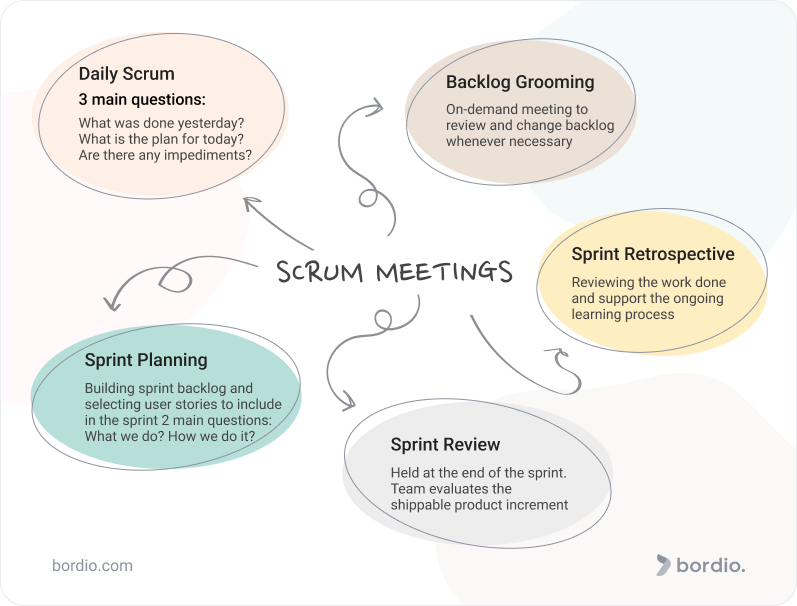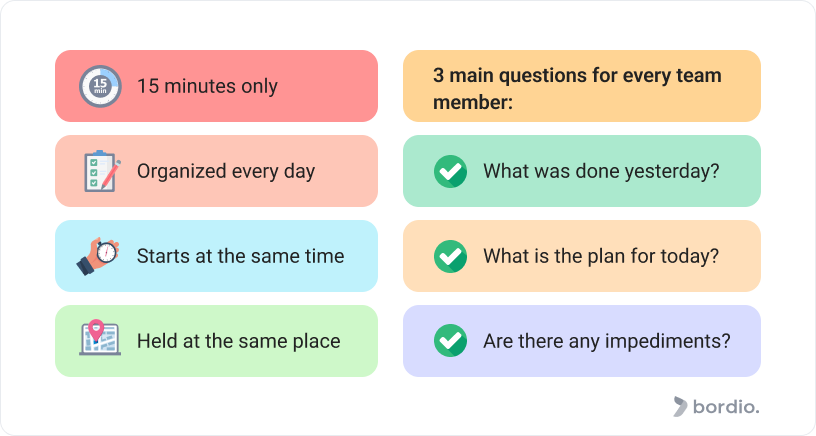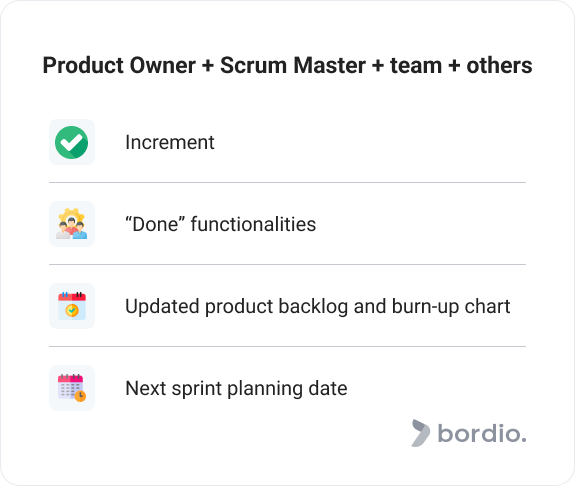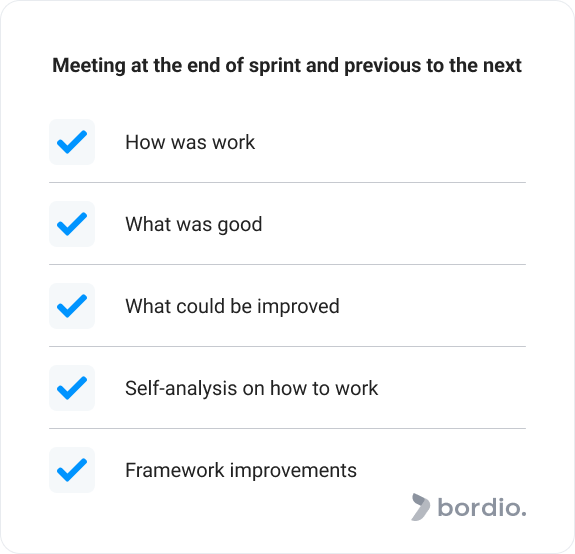Scrum framework includes five central Scrum meetings: sprint planning, backlog grooming, daily Scrum, sprint review, and sprint retrospective.
Today, we will investigate the meetings’ goals, who attends them, what the format is, and how they are beneficial to the sprints and Agile project management as a whole.
Scrum Meeting #1: Sprint planning
This is the first and a very critical Scrum meeting where the Scrum team brainstorms and builds a sprint backlog that determines what user stories will be worked on and what tasks will be implemented until the end of the sprint.
In the sprint planning meeting, the sprint goal is defined and described. It is important to outline what value the sprint will generate. Sprint goals must be realistic and sustainable for the team, so the team’s capacity is measured against the plans.
The sprint planning meeting consists of 2 main parts:
- What we do
- How we do it
The product owner must join this meeting to provide their insight and perspective, clarify the user pains and goals that the Scrum team might not fully understand.
During the sprint planning, the product owner makes sure the requirements and acceptance criteria are fully comprehended by every team member. The next steps of the project should not be taken unless the product owner is confident that the entire team is on the same page.
Tip: Use a shared to-do list online to outline all requirements and criteria during the meeting. That way, using the task tracker, you won’t forget important details and will be able to keep the team accountable for the decisions they’ve made during the planning session in the online time planner.
Only the product owner and the team are active during this Scrum meeting. Other stakeholders can participate but as the audience only. Their input is not required here, and they shouldn’t meddle in with their comments or suggestions.
What is worked on during the sprint planning meeting:
- The sprint goal.
- The duration of the sprint.
- Candidate user stories from the product backlog are reviewed.
- The selected user stories are edited and broken into smaller user stories (when necessary and possible) so that they can be processed during one sprint.
- The team capacity is planned for the upcoming sprint.
- Identifying tasks that have to be completed during the sprint. You should use free daily schedule planner to manage tasks later.
Scrum Meeting #2: Backlog grooming
Backlog grooming, also known as backlog refinement, is a Scrum meeting that happens at the beginning of the sprint and then once every sprint week or sometimes more often on-demand.
Here, the backlog is reprioritized, user stories and resized and refined in preparation for the next sprint. The main goal is to keep the product backlog up to date.
Tip: Schedule recurring backlog refinements meetings in the weekly planner for the team to automatically reserve the time for this ceremony. Teamwork is better when everyone can check tasks in simple weekly schedule planner.
The Scrum team, the product owner, and Scrum Master all participate in this meeting.
Examples of what is worked on and done during the backlog grooming session:
- User stories are added and estimated if new requirements are discovered.
- Outdated user stories are removed. Agile and Scrum, in particular, are both flexible and welcome change. So, if business goals and needs have shifted after the launch of the project, there is no sense in insisting on keeping them in the plan.
- User stories are split into smaller ones if required and possible. It is done to make sure the Scrum team can handle the tasks associated with the user story within the timeframe of one sprint.
- Priorities are updated based on the changes in user stories. To make sure you don’t forget about it create a task in the time organizing app.
Tasks and product backlog are not the same, but the way we manage them crosses over. If you’d like to learn more about working with tasks to implement it in the work you do with backlog, check out the task prioritization guide.
In order for this Scrum meeting to be successful, everyone on the team should participate and share their unique perspective. It is also critical to identify all dependencies and make sure the sprint flow is ongoing without unnecessary downtime.
It is the backlog grooming meeting where risks can be identified and worked through again to avoid nasty surprises down the line.
Scrum Meeting #3: Daily Scrum
Daily Scrum is often referred to as a daily standup meeting.
It is a daily 15-minute meeting that brings the entire team together for a quick recap:
- What was done yesterday?
- What is the plan for today?
- Are there any impediments?
The format encourages transparency and makes sure all members of the project team stay in the loop. Transparency helps the project move forward quicker. The Scrum team feels closer to each other, understands what everyone is doing, and actively helps each other with any issues or queries.
Ideally, the daily standup is scheduled for the same time and place to reduce complexity. The meeting is attended by the developers, Scrum Master, and product owner. The key stakeholders can join, too, but they are highly discouraged from active participation and should only listen.
Alterations to the format are possible, but this Scrum meeting has to stay nice and short and focus on the project progress towards the primary goal.
What are the benefits of running the daily scrum meeting?
The daily standup is sometimes criticized or considered redundant. The common complaint is that there is not much to report outside of what everyone knows already, so valuable time should not be wasted during the busy period of working through the sprint.
That’s why we want to pay special attention to the benefits that Scrum team members can get from this meeting if they follow through.
Scrum teams are not micromanaged. They are given a lot of freedom and rely on self-discipline greatly to achieve good results. Daily Scrum meeting helps keep them motivated and focused. You can then use an accurate online scheduler to update information and add new tasks.
If someone in the team identifies the impediments, the quick decision-making is done right at the meeting, and the plan for the rest of the sprint can be re-adjusted if needed.
Running daily Scrum meetings helps the team stay on track and increases their chances of achieving the sprint goal without having to fast-track. It has to be quick, but all concerns from each team member must be respected and processed.
It is common for the Agile team to practice the meeting while actually standing up. That way, team members are less relaxed and lazy compared to the traditional sit-down meeting. The format gently pushes participants to get to the point faster and let the next person speak because it is not necessarily comfortable to stand up for a long time and just wait.
The Daily meeting is often followed by one-on-one or smaller group meetings where team members have longer and more detailed discussions. It is important to respect the ceremony of daily Scrum, to keep it short and on-point. Any urgent or high-priority matters have to be scheduled separately.
Daily Scrum vs Status Meeting
Daily Scrum is NOT a status meeting.
The purpose of daily Scrum is to track progress, sync activities, and plan the next 24 hours. It is run by the team and for the team. It is daily and short.
During the status meeting, team members come together to report on their progress with the tasks made in online project management tool, to someone who is in control and maintains the plan, e.g. the project manager or team lead.
Scrum promotes self-organization which is the key aspect of Agile. Scrum team members are accountable and in control of what they do next or how they deal with the product backlog.
With status meetings, the team gives up a lot of the control to someone in a higher position or outside of the development team. Here, transparency is often reduced.
The point of daily Scrum is to get valuable outcomes and promote collaboration. In status meetings, the focus is on individual achievements.
Tip: Staying in control of what you do can be achieved in many ways. Using powerful schedule making tool is one of them. Free Daily planners by Bordio help keep track of top priorities and the little things, allowing you to manage deadlines and tasks like a pro.
To sum up
The daily standup meeting achieves the following targets:
- Get a regular update on the current sprint status.
- Identify and eliminate potential risks or issues that the development team has.
- Prompt quick decision-making and avoid delays.
- Improve communication within the development team and with the product owner.
- Share accountability and get everyone on the same page.
- Demonstrate to team members that nobody owns the plan but the team as a whole.
To support the daily standup initiative, consider implementing a communication plan to build healthier communication among team members, and work on team’s accountability, whether you work remotely, in office, or in a hybrid mode. In addition, for those who work remotely, it will be convenient to control the process with a service such as remote team software. Bordio can provide the best collaboration tools for remote teams.
Scrum Meeting #4: Sprint Review
Sprint review meetings are held at the end of the sprint.
The goal is to evaluate the sprint outcome or, in other words, the shippable product increment.
The sprint review meeting does not have to be formal with PPT slides and all, but it needs to focus on the end result evaluation.
The development team demonstrates what they’ve done, and the product owner checks that their delivery matches the requirements committed to during the sprint planning meetings.
Here, the current state of the product is assessed, and the goal for the next sprint can be re-evaluated based on the current sprint result.
The product owner, Scrum Master, Scrum development team – all must participate in the sprint review meeting. Stakeholders can join, too, if they’d like, but their active involvement is not required.
The sprint review meeting is the time for discussion, sharing feedback, and making sure team members are on the same page.
Scrum Meeting #5: Sprint Retrospective
Sprint retrospective meeting is organized after the sprint is finished. The goal of this sprint meeting is to review the work done using the following several goals as benchmarks:
- Improving teamwork and communicating its importance to every team member.
- Improving the application of Scrum principles and processes.
- Increasing productivity and performance, as well as the quality of the product created.
- Tracking what was good and making sure it’s included in the next sprint.
- Identifying what was causing issues and delays and working out the way to remove these obstacles.
- Checking if there are alternative and better ways of doing different things.
- A list of commitments for the next sprint can be drawn up at this point too.
The meeting is not held to blame someone or find mistakes but to have an appreciation for the last sprint and the development team that made it happen. And, of course, it wouldn’t be Agile if the Scrum team didn’t focus on learning from that experience to be better next time.
Systematic improvement is an inherent part of the Scrum framework, so running the retrospective meeting (and other Scrum meetings, for that matter) enables the teams to have an ongoing learning process and enhance their skills and performance over time.
We hope that our article helped you understand the difference between sprint review and sprint retrospective meetings, but if you still have questions or would like to dive deeper into the subject, read our comparison guide on the two Scrum ceremonies.
The role of Scrum Master in Scrum meetings
The Scrum Master role is being a servant to the team. They facilitate the Scrum meetings and other Scrum ceremonies, making sure the teams follow the guidelines of Agile and Scrum, and they are not distracted or disturbed from their main goals and focus.
Scrum Master participates in all meetings, moderates when necessary, and facilitates the best application of the Scrum process. They also guide the team outside of the Scrum meetings.
It is important to point out that Scrum Master oversees the work process and makes sure all necessary ceremonies take place. But they cannot be responsible for the team to do their part.
Many companies hire a certified Scrum Master for their projects, but it can also be sufficient to have an experienced Scrum follower within the company’s workforce who is familiar with all nuances and can guide and advise the Scrum team whenever necessary.
Final thoughts on Scrum meetings
Agile Scrum meetings are critical to the Scrum project management.
Every Scrum meeting plays a different role, but they all serve a common purpose:
- Sprint planning meetings set the tone for the rest of the project as the Scrum team defines the sprint goal and the sprint backlog.
- Daily standup supports the team spirit, helps the sprint stay on track, and spot and remove issues early.
- Backlog grooming helps the project stay true to its core goals but also shift and change if necessary.
- Sprint review meeting is where the Scrum team presents their outcome and finalizes the results of the sprint with other stakeholders.
- Sprint retrospective meeting is an educational Scrum meeting where team members analyze their past experiences and plan for better work in the future.
That’s it for today! We hope that you’ve learned something new about each of the Scrum meetings we covered today. If you are looking for a guide to Scrum to help you better understand the topic, make sure to check out the Bordio blog, where we publish weekly articles about project management, leadership, time management, and more. And also make sure you try Bordio’s calendar planner that is perfect for work with Scrum or other project management methodologies.









